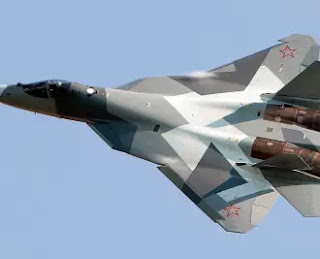These 6th-generation fighter jets will be equipped with lasers which can physically burn an enemy’s missile homing heads. The fighters will also have electromagnetic guns and guided electronic munitions.
While major air forces the world over are looking at acquiring 5th generation fighters, the Russians are already testing systems which will be used for the futuristic 6th generation jets. A few days ago, a Russian Su-57 fighter was used to test onboard systems for the future 6th-generation jet.
These 6th-generation jets will be equipped with lasers which can physically burn an enemy’s missile homing heads. The fighters will also have electromagnetic guns and guided electronic munitions.
According to Russian news agency ITAR-TASS, a source in the country's air defence industry said, "There are no plans to create the unmanned version of the Su-57. It is currently being used to test some systems of the future sixth-generation fighter jet, which will be a drone in its baseline version and only optionally piloted." The onboard systems include "control and navigation equipment and weapon systems".
However, ITAR-TASS also added that there is no official confirmation on the tests for the 6th generation jets by Russia’s United Aircraft-Building Corporation, which developed the Su-57 jet.
Colonel General and former Commander of the Russian Aerospace Forces Viktor Bondarev had in November 2017 claimed that the Su-57 could be developed into a 6th-generation aircraft. Former Russian deputy prime minister Dmitry Rogozin had in March 2016 announced that Russia was working on a 6th-generation fighter and the Sukhoi Design Bureau had made some progress on it.
Russia is also working on developing a radio-photonic radar for its future fighter jets. The radar, once fully developed in a few years time, will be mounted on the 6th-generation jets.
A radio-photonic radar has a much longer range than radars currently in service and will be able to develop photographic images of the targets that can be easily and automatically identified. It will have advanced anti-jamming capabilities while being capable of performing electronic warfare missions, transmit data and be used as a means of communication.
While major air forces the world over are looking at acquiring 5th generation fighters, the Russians are already testing systems which will be used for the futuristic 6th generation jets. A few days ago, a Russian Su-57 fighter was used to test onboard systems for the future 6th-generation jet.
These 6th-generation jets will be equipped with lasers which can physically burn an enemy’s missile homing heads. The fighters will also have electromagnetic guns and guided electronic munitions.
According to Russian news agency ITAR-TASS, a source in the country's air defence industry said, "There are no plans to create the unmanned version of the Su-57. It is currently being used to test some systems of the future sixth-generation fighter jet, which will be a drone in its baseline version and only optionally piloted." The onboard systems include "control and navigation equipment and weapon systems".
However, ITAR-TASS also added that there is no official confirmation on the tests for the 6th generation jets by Russia’s United Aircraft-Building Corporation, which developed the Su-57 jet.
Colonel General and former Commander of the Russian Aerospace Forces Viktor Bondarev had in November 2017 claimed that the Su-57 could be developed into a 6th-generation aircraft. Former Russian deputy prime minister Dmitry Rogozin had in March 2016 announced that Russia was working on a 6th-generation fighter and the Sukhoi Design Bureau had made some progress on it.
Russia is also working on developing a radio-photonic radar for its future fighter jets. The radar, once fully developed in a few years time, will be mounted on the 6th-generation jets.
A radio-photonic radar has a much longer range than radars currently in service and will be able to develop photographic images of the targets that can be easily and automatically identified. It will have advanced anti-jamming capabilities while being capable of performing electronic warfare missions, transmit data and be used as a means of communication.



No comments:
Post a Comment